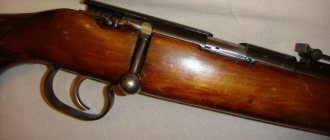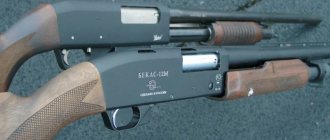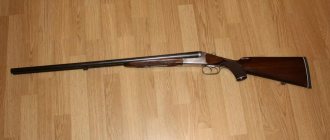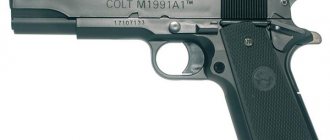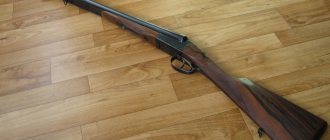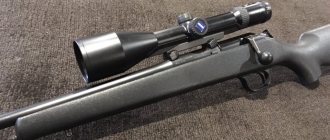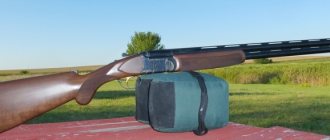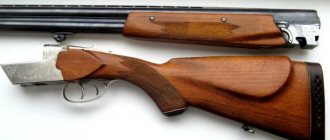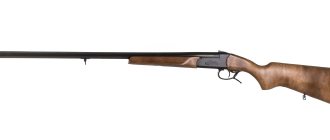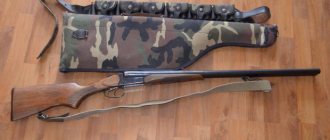The TOZ-66 hunting rifle is well known to experienced hunters. According to users, in this double-barreled shotgun the Tula Arms Plant managed to embody all the advantages of previous hammer-fired shotgun models. The creation of the TOZ-66 12-gauge hunting rifle was a real gift to Soviet hunters who had long dreamed of getting a classic Tula hammer in this caliber.
The technical characteristics of the new model were practically no different from the TOZ-63, but since this weapon was designed to fire 12-gauge cartridges, it received a reinforced design. You can safely go hunting with a double-barreled shotgun, and this weapon is quite versatile. It is suitable for hunting both small and large game.
The history of the appearance of the first Tula double-barreled guns
The Russian Empire, for all its enormous size, did not have its own production of hunting rifles. Rich hunters in Tsarist Russia purchased hunting rifles of foreign brands. Most hunters in the vast expanses of Tsarist Russia hunted with the following weapons:
- Obsolete combat rifles that were decommissioned by the army;
- Shotguns loaded from the muzzle;
- Hunting rifles that were converted by artisans or private factories from military samples by re-drilling rifled barrels.
Although the craftsmen were obliged to maintain quality at a high level, in fact no one did this, since private owners sought to make more profit by devoting a minimum of time to finalizing their crafts.
As a result, domestic hunting rifles were extremely unreliable and were not in stable demand. They were bought more out of desperation.
At the beginning of the 20th century, the Tula Arms Plant produced a sufficient number of Mosin rifles, and orders for their production sharply decreased. Production capacity was freed up and urgently needed to be filled with something. Since the army no longer needed such a quantity of weapons, and the plant could only produce them, it was decided to master the factory production of hunting rifles, which Russian hunters were in dire need of.
The main role in the appearance of the classic Tula hammer double-barreled guns, which were produced without significant changes until the end of the 1970s, was played by the engineer of the Imperial Tula Arms Plant S.A. Zybin. There is an assumption that S.I. had a great influence on the development of the designer. Mosin, with whom young Zybin studied together at the Mikhailovsky Artillery Academy.
After graduating from the academy, Zybin and Mosin were sent to the Tula Arms Plant, where Mosin began to develop, modernize and set up production of his famous rifle, and Zybin became the head of the plant’s workshop, responsible for the production and repair of hunting weapons. Under his leadership, craftsmen began to produce the first hammer-fired horizontal double-barreled shotguns already at the end of the 19th century. Although the use of almost 100% manual labor made the production of Tula hunting weapons almost invisible on the scale of a huge country.
How to handle this weapon
The gun should always be considered loaded and ready to fire, and should never be pointed at people, pets, or simply standing with the gun resting on it. The gun must only be stored unloaded and with the triggers pulled, while the ammunition is stored in a box under a secure lock.
The service life, as well as the trouble-free operation of the 12-caliber TOZ-BM directly depend on how skillfully the owner handles this weapon, as well as how high-quality the ammunition is used.
Inept or careless handling of such a gun, as well as too frequent complete assembly and disassembly, will ultimately lead to a significant reduction in the overall service life of the TOZ-BM. Feedback from owners suggests that the quality of ammunition must also be monitored, not to mention the caliber of your model.
The appearance of the first serial Tula trigger
Since the economic crisis affected the Imperial Tula Arms Factory in 1901, its management faced a difficult choice: disband half of the valuable personnel who had been training for many years, or urgently switch to mass production of hunting weapons. The choice was made, and in 1902, the promising and active head of the production of hunting rifles was sent to Europe on an important mission: to find out the details of mass production.
After returning from a business trip, Zybin wrote a detailed report in which he outlined all the innovations he had seen in European arms factories, and proposed organizing large-scale production of hunting rifles, using the experience of Belgian gunsmiths.
In those years, the creation of a Russian double-barreled shotgun was actively discussed by the public, so Zybin’s proposal was of interest not only to the management of the plant, but also to authoritative experts in the field of hunting weapons of that time. The participation of Butyrlin, Ivashentsev and other specialists in the development of the Tula trigger determined its appearance. The new hunting rifle had the following set of characteristics:
- Low price;
- Exceptional reliability;
- Elegant appearance;
- Simplicity of design.
All tasks were completed, and in 1902 the first small batch of Tula double-barreled guns was produced. The guns were produced in several versions:
- The classic TOZ-B model, which had a simple padlock;
- Guns with “Liege” locks, which were more expensive, were produced in small quantities;
- Shotguns with neck locks.
Until the start of the First World War, the Tula Arms Plant tried to increase production rates, but the war confused all the plans of the management.
Cleaning Features
Cleaning of weapons should be carried out only before traces of powder soot have been completely removed from the surface of the channels. After the cleaning is completed, using an alkaline composition, carefully wipe the stem channels dry and re-lubricate them (you can lubricate them with Vaseline or special oil). The wood of the stock can be wiped with a standard dry rag.
A day after shooting and initial cleaning, the barrel channels should be wiped with a clean, dry cloth, and if you find any traces of rust or carbon deposits, cleaning will need to be repeated as soon as possible. If, after regular cleaning, carbon deposits also remain, it must be softened by thoroughly rinsing the channels with boiling water. After washing, the weapon is re-cleaned in accordance with all requirements and recommendations.
During shooting, lead can be deposited in the bore. In order to remove such lead, you need to use a brush made of steel or copper wire, which is lubricated with special gun oil and then used to wipe the bore. If necessary, you can use a brush made of stiff bristles.
Tula double-barreled shotgun TOZ-B
The first guns of this model were produced in 1902. In 1903, mass production was launched, but it was not very fast. After the revolution, the Soviet government resumed production of the classic Tula TOZ-B double-barreled shotgun. It was produced virtually unchanged until 1941, after which production at the Tula Arms Plant was curtailed due to the need to produce military weapons.
The production of TOZ-B during the Great Patriotic War was entrusted to the Volodarsky artel, which was engaged in assembling these guns from components donated by its Tula Arms Plant. During all the years of the war, no more than a few thousand copies were produced, which are now almost impossible to find.
After the end of the Second World War, production was resumed at the plant, and the classic Tula double-barreled shotgun was produced unchanged until 1957.
The TOZ-B double-barreled shotgun is a classic Tula hammer with padlocks. This is a traditional hunting “break” with trunks located in a horizontal plane. Unlike modern models of Tula double-barreled guns, it had a triple locking system. The triggers of the gun were made separately from the firing pins, and the forend was detachable. It was closed using a special latch.
The Tsarist TOZ-Bs were of much higher quality than Soviet guns. If in the USSR such a gun was considered a working gun, devoid of any frills, then the royal double-barreled shotguns were often even decorated with gold notching. After the Second World War, it was pre-revolutionary guns that were in great demand. There are many known cases when craftsmen took an ordinary TOZ-B double-barreled shotgun, which was produced in the USSR, and through modifications turned it into a “real” royal tulka. Although these guns were fake, after modifications they were practically in no way inferior to guns produced in tsarist times.
Who uses it and where?
Like the standard model, this one was used by almost everyone who had to deal with hunting in professional and everyday life. The popularity of this gun is due to the fact that it is distinguished by an extremely well-thought-out and time-tested design, and, more importantly, by its maintainability, since all parts were widely distributed and, accordingly, available to every hunter. Among other things, many people also appreciated the high degree of durability and reliability of this gun.
For many hunters, an important role was played by the complete absence of a safety lock, as well as the presence of external hammers, thanks to which the weapon could be brought into battle in the shortest possible time, since simply cocking the hammers was quite enough. Also, due to this, the gun could be transported extremely easily with cartridges in the chambers with the hammer pulled, and there was no need to make any unnecessary movements to fire a shot.
Modernization of the Tula double-barreled shotgun
In 1957, the legendary Tula TOZ-B double-barreled shotgun was modernized. This was due to the requirements of the USSR government to expand the range of manufactured guns. The new double-barreled shotgun, in essence, remained the same old TOZ-B, only it was produced in 16 and 20 calibers and, according to the manufacturer, was distinguished by increased strength. The new model was called TOZ-BM. Its guaranteed range was indeed greater, but this was most likely only due to the absence of a 12-gauge model, where the charge was much more powerful and the service life was shorter.
In 1964, TOZ-BM was modernized again. In accordance with the spirit of new times, this double-barreled shotgun began to be produced with improved finishing. At its core, this gun differed only in the presence of a chrome-plated barrel. The new model received the index TOZ-63, and was produced only in 16 and 20 calibers.
It is interesting that along with the new Tula double-barreled shotgun, the old model was also produced. The latest batches also received a chrome-plated bore and were no different from the TOZ-63, except for the stamp with the model name.
In 1968, the Tula Arms Plant pleased the hunters of the USSR with the release of the long-awaited 12-gauge hammer. The new model, called TOZ-66, was produced until 1974, and managed to gain fame as the strongest gun among Tula double-barreled guns. What is noteworthy is that even modern models of TOZ double-barreled guns are significantly inferior in strength to the TOZ-66, which received a reinforced receiver.
How to disassemble
The TOZ-BM shotgun must be assembled and disassembled exclusively in a certain sequence and in full compliance with safety rules. It is also recommended not to use any excessive force or shock in this process. Before starting work, the TOZ-BM 12-gauge shotgun must be completely unloaded.
The very procedure for disassembling this weapon is as follows:
- The forend is separated from the barrels.
- The gun is grasped by the neck of the stock with the right hand, while the locking lever is pulled to the maximum possible right position with the thumb. After this, the trunks smoothly turn down and are separated from the box.
- The screw of the impact mechanisms is turned out.
- The screw is driven from the right side into the base of the right striker and will then be used to carefully separate the right striker.
- Through the hole located in the sear box, the left percussion mechanism is pushed out extremely carefully with a wooden rod.
The main differences between TOZ-66 and other Tula triggers
The new Tula TOZ-66 double-barreled shotgun became the long-awaited 12-gauge novelty that USSR hunters were so missing. This weapon was practically no different from the previous triggers of the Tula Arms Plant, except for the redesigned block and barrel block. Otherwise, the stock, the TOZ-66 butt and all the technical “stuffing” of the gun remained unchanged. Disassembling this weapon was not difficult; it was as easy to disassemble as previous models from TOZ.
The TOZ-66 hunting double-barreled shotgun was absolutely no competition to the TOZ-63, since these models were of different calibers. Like the TOZ-63, the chambers and bores were chrome-plated. By the way, similar chrome plating is used at the Tula Arms Plant on all smooth-bore guns that are produced in our time.
Since a 12-gauge shotgun has larger barrels and a block, the distance between the axes of the barrels has also increased, which led to a slight increase in the weight of the weapon. The TOZ-66 double-barreled shotgun was intended to be the same inexpensive and reliable weapon as its predecessors. The guns were produced in the following modifications:
- Ordinary execution. In this modification, the double-barreled shotgun stock was made exclusively from birch;
- Improved performance. This modification was distinguished by better assembly and a beech stock;
- Piece execution. This modification featured a walnut stock.
In addition, there were also gift modifications of the TOZ-66, which were made exclusively for special orders. They had complex metal engraving and artistic wood carving.
Flaws
If we talk about the shortcomings of the TOZ-BM 12 caliber (photo above), we can note that such guns are not always equipped with really high-quality finishing and firing. You can often find models of this gun that are distinguished by rather poor filing and fitting, and in addition they also have a disgusting action. Thus, the use of a Griner bolt in direct locking necessarily requires a truly high-quality and highly qualified assembly, and otherwise the weapon simply will not be able to really accurately perform the tasks assigned to it.
It is for this reason that the fit of the upper mechanism is often far from the most satisfactory, and this often spoils the TOZ-BM (12 gauge). Piece production somewhat solved the problem, since exclusive models are practically free of any production defects. It is also worth noting the fact that many models are distinguished by far from the best debugging and processing of various parts, often causing well-deserved criticism from the majority of hunters.
Technical characteristics of TOZ-66
The TOZ-66 double-barreled shotgun had the following technical characteristics:
- The block of Tula hammer barrels had a length from 700 to 725 mm. The most common modifications were those with a barrel length of 720 mm;
- The weight of the weapon depended on the length of the barrel and varied from 3.1 to 3.75 kg. This parameter could be influenced by the type of wood that was used to make the stock;
- There were several types of lodges. They differed in the shape of the neck, which could be straight, semi-pistol or pistol. In most cases, the manufacturer installed a universal stock with a semi-pistol neck, which was suitable for the vast majority of hunters;
- The diameters of the barrels often did not correspond to the passport data, and could differ by not a tenth of a millimeter, so the owners measured the diameter with a caliper in order to avoid problems when shooting bullets.
There was also an extremely rare shortened version, which had a barrel block only 510 mm long. Apart from the length, this modification was no different from the standard one.
What to consider
Assembling the impact mechanisms is carried out in the reverse order. It is worth noting the fact that it is worth separating the impact mechanisms only in the process of replacing summer or winter lubricants. It is recommended that complete assembly of the gun be carried out only in cases of extreme necessity, and all work should be carried out exclusively in a properly equipped weapons workshop. The blades of screwdrivers that are used in the process of assembling and disassembling TOZ-BM (12 gauge) must be correctly threaded and also fully correspond to the screw slots.
